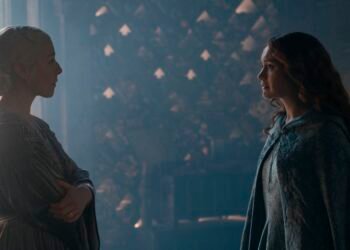Fiction stories often throw around real statistics, using them to frame the stakes or mold audience expectations. For instance, Netflix’s newest anime movie, Children of the Sea, mentions early on that humanity has yet to explore 95 percent of the ocean. This is a popular statistic for stories: Movies like Masaaki Yuasa’s Lu Over the Wall use it to justify introducing mythological creatures from the ocean, characterizing the uncharted sea depths as a source of fear or potential wonder.
It’s certainly easy to fear the unknown. Children of the Sea asks viewers to fall in love with the unknown, and consequently, with the ocean. Director Ayumu Watanabe (Space Brothers) wants the ocean to wash over his viewers, enveloping their entire being. He doesn’t present the water as any different from a person, or a grain of sand. The film suggests we’re all just tiny specks in the vastness of the universe — and presents that as a comforting message. In this story, taken from Daisuke Igarashi’s manga series, everything is connected. The sea needs to be admired and explored because it’s a large part of ourselves.

Children of the Sea expertly prepares its message from the start. The film opens at an aquarium where the protagonist, Ruka, is entranced by a school of fish following her movements. It’s a brief, wonderful encounter that sets up the rest of the film. Aquatic life is depicted in a painterly fashion, reminiscent of impressionist art. STUDIO4°C’s animation ensures that every scene featuring even a droplet of liquid is absolutely stunning.
The movie portrays water in such a breathtaking way that it’s difficult to not get drawn in. Every gil, dorsal fin, and flipper feels so vividly drawn that it’s like being in the actual ocean. As the film progresses, the underwater scenes grow in complexity, highlighting the ocean’s natural beauty. But these scenes feel earned rather than overwhelming, as if the entire film has been building up to the unification of the ocean and the audience.
Backing the scenery is an equally impressive score by longtime Studio Ghibli composer Joe Hisaishi. Like the scenery, Hisaishi’s score evokes curiosity. There’s also a certain quietness to it, contrasting with the film’s many speedily swimming fish. At its best, Children of the Sea steadily envelops viewers with curiosity, drive, and calmness. It’s a sensory concert.
Children of the Sea’s actual narrative feels shallow compared to the other elements. Ruka is a caustic young girl whose father helps run an aquarium. On a rainy day, Ruka meets a young boy named Umi in the aquarium. Allegedly, Umi and his foster brother Sora were raised by dugongs. Due to this uncommon upbringing, they’ve spent much of their life underwater, which has significantly shortened their lifespan.

Image: GKIDS
The three children have a supernatural connection to the ocean, drawing them to travel into deeper waters. This eventually lets them interact with a collection of ocean life. This voyage is all well and good, but there’s little reason to care for it. The three leads feel like tour guides and audience surrogates, rather than compelling characters. That dynamic extends to the supporting cast, who spend much of their screen time praising the ocean’s wonders.
All three leads are forgettable, and screenwriters Daisuke Igarashi and Hanasaki Kino don’t seem to know how to treat them. By the final act, the trio’s presence is further muddled, as the film begins to further favor vivid imagery and the connection to the sea over their story development, making the action a bit difficult to parse.
All three of them are meant as audience avatars, connecting to nature and realizing that humanity is a part of it. The film takes the stance that every person, animal and water droplet are both a tiny part of the universe, and a reflection of the whole universe. This duality is intriguing enough to make the film worth watching, but there’s no reason why these particular characters needed to be present to convey it.

Nevertheless, Children of the Sea is a gorgeous film that shouldn’t be missed. While the narrative is shallow, its visual and philosophical offerings hit the mark. At its best, the movie steadily envelops viewers with curiosity, drive, and an ineffable beauty. And its warm messaging is a comfort, even in a vast and complicated universe.
Children of the Sea is streaming on Netflix, available on Amazon in subtitled and dubbed formats, out on Blu-ray and DVD, and rentable on a variety of streaming platforms.
























































